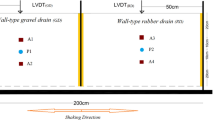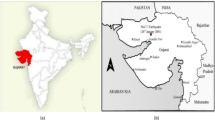Abstract
Gravel-tire chips mixture (GTCM) as an alternative geomaterial has been introduced in recent years. In addition to its low-carbon-released characteristics, other advantageous material characteristics include lightweight, excellent vibration absorption capability, and high permeability. A newly designed earthquake-induced liquefaction mitigation countermeasure has been proposed. This so-called GTCM drains technique utilized GTCM as the material for precast drains installed around existing infrastructures located on the liquefiable ground. During the earthquake, the excess pore water could be dissipated through the drains, therefore, mitigating the potential of liquefaction. However, the deformation characteristics which has a significant influence on foundation settling post-earthquake, are not clearly researched on such improved ground. In this research, based on modelling experiment on 1-g shaking table, Particle Image Velocimetry (PIV) has been used to track and analyse the deformation of the ground foundation during dynamic loadings. The results indicate that with GTCM drains installed, the movement and acceleration of the foundation beneath the on-surface structure were limited. Meanwhile, the excess pore water pressure increased much slower due to the combined effect of drainage and less ground deforming. This study on the deformation characteristics proves the effectiveness of such liquefaction mitigation technique from another perspective.
Access provided by Autonomous University of Puebla. Download conference paper PDF
Similar content being viewed by others
Keywords
1 Introduction
Every year, approximately 1 billion waste tires are produced in various parts of the world. In Japan, according to the report by JATMA [6], the total number of end-of-life tires produced was 86 million, which was near 1 million tons by weight in 2020. To recycle such industrial waste, scrap tire-derived materials (STDMs) have been utilized as geomaterials in recent years. In addition to its low-carbon-release characteristics when used as geomaterials, other advantageous material characteristics of STDM include lightweight, excellent vibration absorption capability, and high permeability. Furthermore, unlike other granular geomaterials, these materials are non-dilatant in nature [1]. They can replace other traditional materials (such as gravel) in applications such as drainage, leachate removal in landfills, soil reinforcement, and so on because of these characteristics. Gravel-tire chips mixture (GTCM), as an alternative geomaterial, has been introduced by Hazarika et al. [2].
One of Large-scale earthquake-induced hazards, liquefaction, has become much too common in recent years, especially in Japan. During the 2016 Kumamoto Earthquake, as an example, several areas in the southern part of Kumamoto City experienced liquefaction causing damage to residential houses due to differential settlement [3]. To prevent the extreme damage to buildings caused by liquefaction during earthquakes, an appropriate and cost-effective disaster mitigation technique called GTCM drains has been proposed (Fig. 1). It utilized GTCM as material of precast drains installed around existing infrastructures located on liquefiable ground. During earthquake, the excess pore water could be dissipated through the drains therefore mitigate the potential of liquefaction.
In this paper, the deformation characteristics which has significant influence on foundation settling post-earthquake on GTCM drains improved ground are researched. Model test using 1-g shaking table facility was performed. Particle Image Velocimetry (PIV) has been used to track and analyse the deformation of ground foundation during dynamic loadings.
2 Model Experiment
2.1 Test Model
Model test was conducted using the 1-g shaking table facility at the geo-disaster laboratory of Kyushu University as shown in Fig. 2. Soil-structure-fluid interaction can be simulated using the scaling law proposed by Iai [5]. Since this research involves liquefaction induced damage to on-surface structure, it is the most suitable similitude relationship. A geometrical scaling factor of 1:32 was set based on this law in this model test.
Toyoura sand was used as foundation soil in these tests. A dense layer of such sand (Dr = 90%, 200 mm in depth) representing non-liquefiable ground was constructed using both dry deposition and tamping techniques. The upper liquefiable layer (Dr = 50%, 300 mm in depth) was constructed only using dry deposition technique. The saturation process could be performed by percolating water gradually and uniformly through 3 water inlets from the bottom of the container. GTCM with volumetric gravel fraction of 50% was used to make drains. The properties of the materials are shown in Table 1.
2.2 Test Conditions
Figure 3 shows the layout of the test model in this research. Six vertical GTCM drains are arranged symmetrically along the long side of the model building, installed from the surface level up to the bottom of the loose sandy layer, and extended into the hard layer. Another four GTCM drains are inserted at 60 degrees diagonally along the short side of the model building. The diameter of these prefabricated GTCM drains is 50 mm with a height of 300 mm. Since heavy building could settle more due to its weight rather than the influence of liquefaction [4], a shallow foundation of a building with a bearing pressure of 3 kPa, represented by a rectangular block of brass material, with a cross-sectional area of 230 × 100 mm in model scale, is set upon the soil. In addition, there is a thick layer of gravel with 2 cm in depth between the model building and GTCM drains. A sinusoidal acceleration of 200 Gal with the frequency of 4 Hz and duration of 10 s is applied to the model. Several pore water pressure transducers are set in the location shown in Fig. 3b. Two motion analysis marks are located at two side of the model building.
3 Results and Discussion
3.1 Settlement
The model building suffered settlement due to the deformation of the loose sand foundation, as shown in Fig. 4a. Through motion analysis, the time history and trend of the building settling are obtained and drawn out in Fig. 4b. At D1, the maximum settlement is 37.45 mm. While at the other side (D2), the value is recorded as 32.32 mm. The rotation due to the uneven settlement was about 1.28º.
3.2 Excess Pore Water Pressure Ratio
Figure 5 shows the time history of excess pore water pressure ratio, defined as \(R_{u} = u_{expp} /\sigma_{vo}^{{}}\), recorded by PPTs at each location inside the loose sandy layer (shown in Fig. 3b). As a benchmark, in the shallow layer of free-field, with no influence from any drains, only P4 reaches the fully liquefied value of 1. Other than that, the Ru initiates a speedy increase as the earthquake started and remains in high value until the end of shaking at P3, P4, P7 and P8. On the contrary, the Ru at P1, P2, P5 and P6, surrounded by GTCM drains, remains at a low level. The GTCM drains, therefore, did effectively dissipate the excess pore water and make a great effort in preventing liquefaction. Since liquefaction was not observed beneath the building, the settlement described in the previous section is assumed to be caused only by the loose soil consolidation.
3.3 Velocity Fields
Figure 6 depicts velocity fields during two cycles of sinusoidal dynamic loading, obtained from PIV analysis. The analyze area is 400 × 70 mm. Large velocities are observed in the loose sand soil foundation accompanied by the sinusoidal accelerating of the shaking table. Figure 6a shows the velocity field in a cycle after the shaking table reached the acceleration of 200 Gal (t = 9 s). As the shaking continued, the consolidation of the loose sandy ground results in the settling of the model building. The soil is also found to be pushed upward into the gravel cap layer simultaneously. As a comparison, Fig. 6b shows the velocity fields in a cycle during the post-consolidation phase (t = 16 s). Though large velocities are observed in areas, the foundation rocks much more slightly. Indeed, the velocity under the foundation is negligible compared to that further away, as well as the cycle described in Fig. 6a. However, due to the rotations of the shallow foundation, the upper soil of inclinedly-installed GTCM drains deforms more significantly. The after-deformation foundation surface, on the other hand, has the similar shape of the velocity fields of the soil beneath.
4 Conclusions
In this study, the deformation characteristics of GTCM drains improved ground under existing building was carried out through model test. The results indicate that with GTCM drains installed, the movement and deformation of foundation beneath the on-surface structure could be limited, especially during the post consolidation phase. Meanwhile, the excess pore water pressure increased much slower due to the combined effect of drainage and less ground deforming. However, the influence of GTCM drains arrangement to the ground deformation is significant. To figure out the deformation situation beneath the foundation, which could not be observed through model tests, the Finite Elements Method would be used to do numerical simulation in the following research. This study on the deformation characteristics proves the effectiveness of such liquefaction mitigation technique from another perspective.
References
Hazarika H (2013) Paradigm shift in earthquake induced geohazards mitigation-emergence of nondilatant geomaterials. In: Keynote lecture for the annual conference of Indian geotechnical society. Roorkee, India
Hazarika H, Abdullah A (2016) Improvement effects of two and three dimensional geosynthetics used in liquefaction countermeasures. Jpn Geotech Soc Spec Publ 2(68):2336–2341
Hazarika H, Kokusho T, Kayen RE, Dashti S, Fukuoka H, Ishizawa T, Kochi Y, Matsumoto D, Furuichi H, Hirose T, Fujishiro T, Okamoto K, Tajiri M, Fukuda M (2017) Geotechnical damage due to the 2016 Kumamoto earthquake and future challenges. Lowl Technol Int 19(3):189–204
Hu Y, Hazarika H, Pasha SMK, Haigh SK, Madabhushi GSP (2021) Effect of bearing pressure on liquefaction-induced settlement in layered soils. In: Hazarika H, Madabhushi GSP, Yasuhara K, Bergado DT (eds) Advances in sustainable construction and resource management, vol 144. Lecture Notes in Civil Engineering. Springer, Singapore, pp 261–270
Iai S (1989) Similitude for shaking table tests on soil-structure-fluid model in 1g gravitation field. Soils Found 29(1):105–118
Japan Automobile Tyre Manufacturers Association (2021) Tyre industry of Japan. Retrieved from http://www.jatma.or.jp/media/pdf/tyre_industry_2020.pdf
Acknowledgements
The authors would like to acknowledge the financial support provided by Kyushu University under Progress 100 project. This study was also supported by JST SPRING, Grant Number JPMJSP2136. Thanks to Mr. Yuichi Yahiro, technical assistant of Geo-disaster Prevention Laboratory of Kyushu University, for his help and support while conducting experiments.
Author information
Authors and Affiliations
Corresponding author
Editor information
Editors and Affiliations
Rights and permissions
Copyright information
© 2023 The Author(s), under exclusive license to Springer Nature Switzerland AG
About this paper
Cite this paper
Hu, Y., Hazarika, H. (2023). Deformation of Earthquake Resistant Gravel-Tire Chips Mixture as Drains. In: Atalar, C., Çinicioğlu, F. (eds) 5th International Conference on New Developments in Soil Mechanics and Geotechnical Engineering. ZM 2022. Lecture Notes in Civil Engineering, vol 305. Springer, Cham. https://doi.org/10.1007/978-3-031-20172-1_40
Download citation
DOI: https://doi.org/10.1007/978-3-031-20172-1_40
Published:
Publisher Name: Springer, Cham
Print ISBN: 978-3-031-20171-4
Online ISBN: 978-3-031-20172-1
eBook Packages: EngineeringEngineering (R0)










